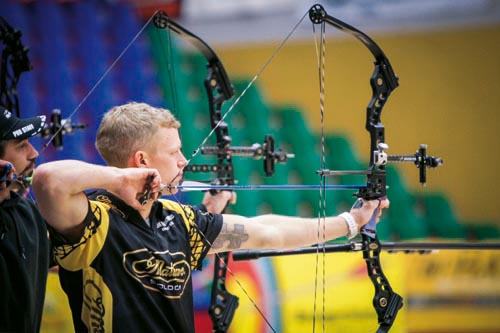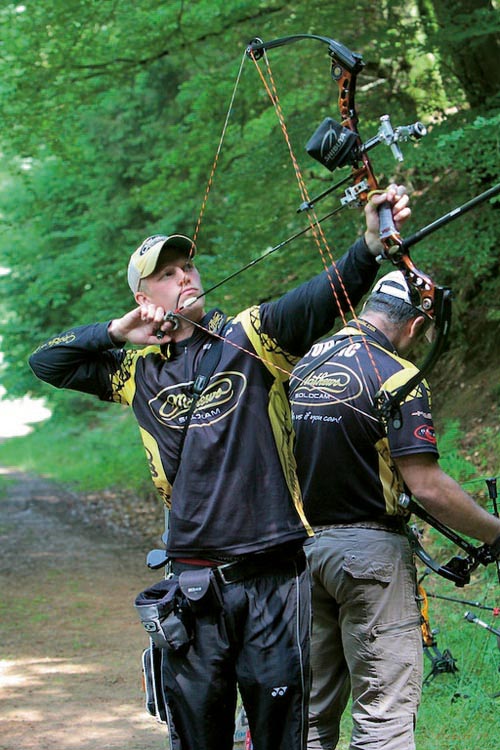For many people bow tuning can be a bit of a mystery. The purpose of this article is to break it down into four simple sections, with some greater detail on one of them, which in my opinion the most important one. I have shot a number of different bows and setups, but the French tune has always been the essential ingredient to a great shooting bow.
- Paper Tuning: It is very important for me that when I get a brand new bow and begin setting it up, paper tuning is the first port of call. I will initially set the bow to shoot a perfect bullet hole at around three yards from the paper. This tells me that my arrow is coming out of the bow straight and that I have no contact or poor flight issues. Poor flight can drastically affect your scores, and arrows that fly badly waste energy and are much more affected by wind, so paper tuning is always the first of my four steps.
- French Tuning: This is more commonly known as a walk back tune. This ensures that your arrows are flying in a straight line. Whether you shoot target or field, the French tune is hugely important, as a correct one will ensure that you do not need to adjust your windage as you move up and down distances. For a field archer if you are changing distance every three or four arrows you will soon loose track of any right-left discrepancies on your arrow impact.
- Stablisation: Now that I have my rough setup it’s important to get the bow holding well on the target. More advanced tuning can’t be carried out on a bow until it is aiming perfectly for you. Stabilisation is very specific for each individual person so this is definitely something you can’t just copy. It’s important to get yourself the stiffest stabiliser bar possible, as this will give you the greatest chance of the weight working efficiently to stabilise your bow. I like a lot of weight on the tip of my bow but that is individual to me. You need to take time to experiment how you like your bow balanced to get the most out of it. Experiment with tip weight, rear weight and side weight until you find the perfect combination.
- Group Tuning: At this point I have a bow which is probably shooting good groups, but I would definitely want to see if I could tighten them up any further. This section of tuning is very much trial and error for me; adjust something, shoot some ends with it, then ask yourself is this better or worse than what I had before? Always try to give everything you try a fair chance.
Some ideas of what I adjust are:
- Nock point up/ down
- Tiller (which also adjusts nock point) – Nock point and loop configuration – Brass weights on top/bottom of string, even or uneven numbers and position
- Arrow spine
- Point weight
- Nock type
- Blade thickness
However, I now want to take a specific look at French tuning and exactly how it’s done. It’s important to note this should only be done on a perfectly calm day, or indoors if you have the facility to do so, as it will be dramatically affected by wind.
Get yourself a small target face, I generally use a bunny (20cm) face from a FITA field round. To begin, set yourself up at just three yards from the target and sight your bow in on the 20cm face. Don’t stop this until your bow is hitting dead centre with every shot.
Walk back approximately 45 yards and, without adjusting your sight, shoot three arrows at the same face. Because you shot the first lot of arrows at three yards, your sight tape had turned over, so there should be no need to adjust the vertical on your sight. Three yards and 45 yards should have roughly the same sight mark. To make your life easier, if you are a little low at 45 yards go a few yards closer, and if you are high at 45 yards then walk a few yards back. This will mean you should not have to touch your sight’s vertical adjustment during the process and you will hit the same spot at both distances.
Go down to the target and take a look at the distribution of where your arrows have landed. Remember you are only looking at the horizontal placement of your arrows, and not the vertical. If the centre of the group is in line with the centre of the target then your centre shot was correct to begin with, but in most cases it probably won’t have been.
If your arrows hit to the left of the centre at 45 yards then you need to move your blade to the right a little, and vice-versa If your arrows hit to the right. Be sure to only move the blade a small amount at this stage, as moving the rest a little has a big impact on where your arrow lands.
not correct repeat
until your arrows shoot at a perfect line up and down through the distance change. It may take a few trips backwards and forwards until you get the French tune perfect, but it will be worth it in the long run.
Once your French tune is correct and your sight is levelled, as I mentioned you should be able to move back and forth between distances and only need to adjust your sight’s vertical placement. For a field shooter the perfect French tune should take priority over the paper tune. I have found on my Conquest 4 that having the perfect French tune gives me a very slight nock right tear through paper. I could move my rest out of the bow to give a perfect paper tear but that won’t gain me any points when I’m out on a field course. The perfect French tune will save me a huge number of points in competition and stop me unnecessarily missing left and right throughout the course.
In order to carry out this process you will find it much simpler if you have a rest that has a micro-adjustment system. Personally, I use the Trophy Taker SS Pro rest, which has extremely fine adjustment of movement and allows me to perfect my French tune.
One thing that is important to note is that the paper tune is very much a starting point. All new bows I get are paper tuned first before all other setup work is done to them. Sometimes when I get a bow shooting really well it won’t always have a perfect hole through paper. The Mathews Apex 8 that I used to set the 2 x 70m European Record a few years ago shot a 15mm high tear through paper. So the paper tune was not perfect, but the French tune was and I used the exact same setup to win the IFAA European Field Championships in Portugal just a month later. The paper tune is great foundation to work from but does not always mean it’s your best option available to you. I make sure every bow I use French tunes perfectly, because field archery and constantly changing distance is such a huge part of my schedule.



